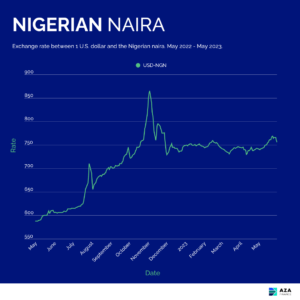Nigeria: Fuel subsidy scrapped in Nigeria.
Ghana: IMF deal eases Ghana’s debt distress.
South Africa: Increased pressure remains on the rand with electricity supply constraints.
Egypt: A planned boost for the Egyptian manufacturing sector.
Kenya: CBK retains the Central Bank Rate at 9.50%.
Uganda: Increased development in Uganda’s telecoms sector.
Tanzania: Investor confidence holds despite the weakening Tanzanian shilling.
XOF Region: The central bank injects XOF 6,300 billion into the interbank market.
XAF Region: Cameroon and China have signed a financing agreement of XAF 18,367 billion.
Nigerian Naira (₦)
Compiled by Ikenga Kalu
Over the week, the Nigerian naira appreciated marginally against the U.S. dollar from USD/NGN 766 to USD/NGN 756 as at the time of writing.
The inauguration of president Bola Tinubu took place this week and was promptly followed by statements that he would be canceling the $10 billion fuel subsidy that is currently in place, as well as plans to target a uniform exchange rate. Bonds and equities reacted positively to the news and rallied on inauguration day. As the above-mentioned reforms take shape in the coming weeks and months, we expect the naira to appreciate gradually against the dollar in the parallel market.
Further reading:
Bloomberg – Nigeria Bonds Set for Biggest Gain in Month as Tinubu Takes Over
Nairametrics – Why the naira will likely be stronger in the black market after May 29

Ghanaian Cedi (GH¢)
Compiled by Murega Mungai
The Ghanaian cedi traded from 11.50/90 USD/GHS as at close of last week to 11.75/12.05USD/GHS this week. This comes after increased demand was seen for the U.S. dollar with the market taking advantage of the gains on the cedi following closure of the International Monetary Fund deal earlier in the month. The deal is expected to ease Ghana’s debt by the year 2028, according to the International Monetary Fund. However, the bulk of the domestic debt restructuring process has been completed. Going in the coming day we project the currency to trade within 11.50-11.90 levels.
Further reading:
Bloomberg – IMF Deal Makes Ghana’s Cedi One of May’s Best Currency Plays
Myjoyonline-Pressure mounts on cedi; loses 9% in value to dollar last week
Myjoyonline-Ghana expected to reach moderate risk of debt distress by 2028 – IMF
South African Rand (R)
Compiled by Alex Barmuta
The South African rand ended last week on the backfoot – closing at a USD/ZAR rate of 19.6171. The new week did not provide any relief, as the Rand trades at around 19.80 levels against the U.S. dollar as of Wednesday.
A lack of clarity on a new U.S debt ceiling agreement, along with weaker than expected Chinese PMI data (indicating that their economic recovery is losing steam), has investors shying away from perceived risky assets.
Back in South Africa, an anticipated increase in electricity demand in winter, along with a continued threat of sanctions and capital outflows (relating to the Russia/Ukraine allegations) continue to create additional pressure on the rand and is illustrated in its elevated trading levels.
Looking at the week ahead, we can expect the rand to trade in the 19.50 – 20.00 range against the U.S. dollar..
Further reading:
CNN – China’s economic recovery loses steam as factory production contracts further
Mybroadband – Reserve Bank warns sanctions over Russia-Ukraine stance could hammer South Africa

Egyptian Pound (EGP)
Compiled by Mitchell Diedrick
The Egyptian pound traded around 30.94 (USD/EGP) at the time of writing, depreciating marginally from 30.8839 against the U.S. dollar at the close of last week.
In a financial statement to parliament this week, the Egyptian government highlighted their plan to allocate approximately 100 billion pounds towards the manufacturing sector for the 2023/2024 financial year. The investments are expected to generate circa 390 billion pounds for that financial year and show a 20% increase compared to that of the previous financial year.
Egypt continues to face a shortage of hard currency evident by the deferral of some payments for large wheat imports that are used mainly for subsidized bread. The finance ministry has also stated that they are expecting an increase of around 42% in the cost of food subsidies in the 2023/2024 financial year.
In the week ahead, we expect a mild depreciation of the Egyptian pound against the U.S. dollar in light of recent dollar strength. S&P Global PMI sits on the economic calendar for 5 June and should shed some light on manufacturing inflation conditions in Egypt.
Further reading:
Egypt today – Egypt’s gov’t allocates LE 100.7 bln as direct investments into manufacturing sector
Reuters – Egypt defers payments for wheat imports amid dollar crunch

Kenyan Shilling (KSh)
Compiled by Terry Karanja
The Kenyan shilling dropped to the levels of 138.45/80 (USD/KSh) from 137.70 /138.25 (USD/KSh) the previous week due to the sustained pressure from oil importers and the manufacturing sector. During the Monetary Policy Committee Meeting held on Monday, the Central Bank of Kenya (CBK) retained the base lending rate at 9.5%.
In an effort to support the Kenyan economy as it confronts high debts and a weakening currency, the World Bank on Tuesday approved a $1 billion loan. The lending will be done through a Development Policy Operations loan, aimed at reducing the debt burden, improving agricultural competitiveness and improving governance. The CBK foreign exchange reserves continue to provide adequate cover and a buffer against any short term shocks in the forex market and currently stand at USD 6,495 million (3.61 months of import cover). The shilling could see some more pressure in the coming week related to increased end month forex demand.
Further reading:
Reuters – World Bank approves $1 billion loan to Kenya

Ugandan Shilling (USh)
Compiled by Yadhav Panday
This Wednesday, May 31, USD/UGX rose 0.40% from last Friday to trade at 3,775.00. In retrospect, USD/UGX has risen 1.2% over the past four weeks. The Uganda Communications Commission (UCC) announced this week that part of the 36 billion UGX from the Universal Service Access Fund will be used to expand ICT services and deepen the adoption of telecommunications services across the country.
Looking ahead, we forecast the Ugandan shilling will strengthen against the U.S. dollar due to the positive news from the UCC as well as Tanzania Port Authority (TPA) currently in talks with Uganda as Uganda plans to start oil production in 2025.
Further reading:
Monitor- UCC to invest Shs36b in expanding digital economy

Tanzanian Shilling (TSh)
Compiled by Kristin Van Helsdingen
The Tanzanian shilling weakened further against the U.S. dollar this week and on May 25, 2023 hit its weakest level since 2017 at USD/TZS 2,366. This week the shilling has remained around the same levels and is currently at USD/TZS 2,365 at the time of writing.
While Tanzania’s FX rate seems to be weakening gradually, the situation on the ground seems to be indicating the contrary. Demand for the 364-day Treasury Bill increased this past month resulting in its yield moving from 6.74% last month to 7.22% in last week’s auction. Additionally, the Dar es Salaam Stock Exchange (DSE) has reported a bullish market for the past three weeks.
As investors continue a risk off approach, we expect the Tanzanian shilling to continue weakening against the U.S. dollar in the week ahead. We expect USD/TZS to continue trading around 2,366 and possibly move to as high as 2,370.
Further reading:
AFRICA PRESS – DSE experiences three weeks of bull run
AFRICA PRESS – T-bill yield up, threatens banks’ deposits
ING – The Commodities Feed: Risk-off sentiment prevails
West African CFA Franc Region (XOF)
Compiled by Jean Cédric Nando KOUA
The central bank has injected liquidity of XOF 6,300 billion into the interbank market.
In order to cover the weekly needs of commercial banks, the central bank injected 6.300 billion XOF – remunerated at a minimum of 4.7% – against a total demand estimated at 6,681.61 billion XOF. These conditions for the refinancing of commercial banks follow the tightening of monetary policies initiated by the central bank in order to bring inflation below the economic union threshold of 3%.
Further reading:
Sika finance – WAMU: The BCEAO injects 6,300 billion FCFA into the interbank market
Central African CFA Franc Region (XAF)
Compiled by Jean Cédric Nando KOUA
Cameroon and China have signed a financing agreement of XAF 18,367 billion.
As part of the deployment of the 2020-2030 national development strategy, Cameroon signed on May 29, 2023, a financing agreement of XAF 18,367 billion with China. This funding should be injected – both in the public and private sectors – into projects with high potential.
This partnership is timely because it will allow Cameroon to truly implement its development strategy.
Further reading:
Sika finance – The Chinese sovereign wealth fund plans to invest 30 billion USD in Cameroon











